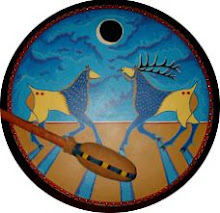 |
| Scalpo steso su telaio - zona delle Pianure- |
La mutilazione dei nemici morti è spesso menzionata nei resoconti storici e etnostorici dello stato di guerra delle pianure. L'usanza di scalpare era la più comune forma di mutilazione, sul cui significato si è molto scritto. Uno scalpo era riconosciuto semplicemente come un trofeo, "un emblema di vittoria" da riportare al villaggio per danzarlo e gioire ancora" (Grinnell)
Altre parti del corpo servivano al medesimo scopo. Al ritorno da una spedizione di guerra gli scalpi ed altre parti del corpo prese come trofei erano preparate dalle donne per i festeggiamenti della vittoria ottenuta. Presentandosene l'opportunità anche le donne rivestivano un ruolo attivo nella mutilazione dei nemici morti. Eastman descrive una donna Sioux che "tagliò le mani ed i piedi di un qualche piccolo bambino Chippewa. e iniziò a lavorarli e cucirli per un necklace".
 |
| Trofeo con perline, denti d'alce e metacarpi umani - Crow |
"l'azione delle donne anziane di evirare il corpo morto dei nemici maschi è ben documentata negli scritti di altri attenti osservatori dello stato di guerra degli Indiani delle Pianure a partire dal 1790. Jean-Baptiste Truteau, un esperto commerciante Francese e attento osservatore delle tribù del Middle Missouri, ha descritto le furiose mutilazioni dei nemici morti da parte delle donne anziane: "Ho visto queste vecchie furie... tagliare via le mani e le parti virili dei nemici morti, mettersele attorno al collo o alle orecchie e danzare con esse davanti a tutti gli ingressi delle tende del villaggio" (Ewers 1997).
...Gli Assiniboine (Kennedy 1972), i Blackfeet (Ewers 1958), gli Cheyenne (Bourke 1892, Powell 1969), i Cree (Ewers 1958), i Crow (Ewers 1958; Denig 1930:491; Ruger 1888), i Pawnee (Grinnell 1923), i Sioux (Carrington 1896; Eastman 1849; Goodrich 1997; Marquis 1986) e gli Ute (Hamilton 1907) sono tutte tribù di cui sono stati riportati casi di taglio delle mani dei nemici durante le ostilità.
Edward Denig, un commerciante nelle Pianure settentrionali durante la metà del 19° secolo, aveva molti buoni contatti con gli Indiani delle Pianure e scrisse sulla mutilazione di parti del corpo:
“ Non c’è alcun motivo religioso dietro il compimento di questi atti, e essi non sono fatti nella prospettiva di placare l’animo degli amici morti o come un sacrificio al Grande Mistero; niente nelle loro parole e azioni in queste situazioni fa pensare a qualcosa del genere; invece tutto ciò è solo insulto verso il nemico morto, e gloria selvaggia e vendetta per soddisfare se stessi”.
Nel Nord Ovest Lewis e Clark furono sorpresi nello scoprire l’uso del taglio della mano e del conservare le dita come trofei da parte di un gruppo Chinookan sul Columbia River, vicino Dalles.
-------------------------------------
The mutilation of dead enemies is often mentioned in historical and ethnohistorian stories about the Plains state of war. The practice of scalping was the most common form of mutilation, the meaning of which was written a lot about. A scalp was recognized simply as a trophy, "an emblem of victory" to return to the village to enjoy and dance it yet "(Grinnell)
Other body parts were used for the same purpose. Upon returning from a military expedition scalps and other body parts as trophies were taken by women and prepared for the celebration of the victory. Whenthere was the opportunity even the women played an active role in the mutilation of dead enemies. Eastman describes a Sioux woman who "cut off the hands and feet of some small child Chippewa children and began to work them and sew them to a necklace."
"The action of older women to emasculate the dead body of the enemy males is well documented in the writings of other keen observers of the state of war of the Plains Indians from 1790. Truteau Jean-Baptiste, a French merchant and expert observer of tribes of the Middle Missouri, described the furious mutilation of dead enemies by older women: "I saw these old mad ... cutting off hands and parts of dead enemies manly, to stretch herself around the neck or ears and dance with them in front of all the entrances to the tents of the village "(Ewers 1997).
The Assiniboine ... (Kennedy 1972), the Blackfeet (Ewers 1958), the Cheyenne (Bourke 1892, Powell 1969), the Cree (Ewers 1958), The Crow (Ewers 1958; Denig 1930:491; Ruger 1888), the Pawnee (Grinnell 1923), the Sioux (Carrington 1896, Eastman 1849, Goodrich 1997, Marquis 1986) and Ute (Hamilton 1907) are all tribes of which have been reported to cut the hands of the enemy during hostilities.
Edward Denig, a trader in the northern Plains during the mid-19th century, had many good contacts with the Plains Indians and wrote on the mutilation of body parts:
"There is no religious reason behind the performance of such acts, and they are not made with a view to appease the souls of dead friends or as a sacrifice to the Great Mystery, nothing in their words and actions in these situations suggests something like that, instead everything is just insult to the dead enemy, and wild glory and revenge to suit themselves. "
In the North West Lewis and Clark were surprised to discover the use of the cutting off of hands and keep your fingers as trophies by a group Chinookan on the Columbia River, near Dalles.
 |
|
radiografia di un trofeo/necklace Apache
















